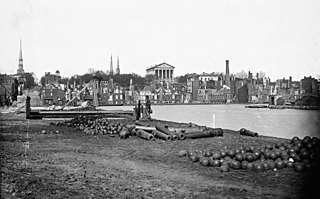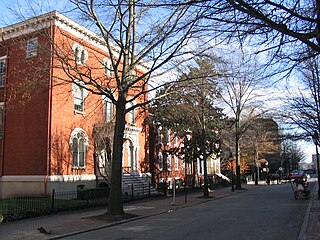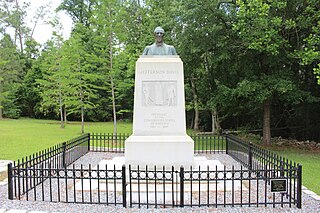
The Confederate States of America (CSA), commonly referred to as the Confederate States (C.S.), the Confederacy, or the South, was an unrecognized breakaway republic in the Southern United States that existed from February 8, 1861, to May 9, 1865. The Confederacy comprised eleven U.S. states that declared secession and warred against the United States during the American Civil War. The states were South Carolina, Mississippi, Florida, Alabama, Georgia, Louisiana, Texas, Virginia, Arkansas, Tennessee, and North Carolina.

The president of the Confederate States was the head of state and head of government of the Confederate States. The president was the chief executive of the federal government and commander-in-chief of the Confederate Army and Navy.

Monument Avenue is a tree-lined grassy mall dividing the eastbound and westbound traffic in Richmond, Virginia, originally named for its emblematic complex of structures honoring those who fought for the Confederacy during the American Civil War. Between 1900 and 1925, Monument Avenue greatly expanded with architecturally significant houses, churches, and apartment buildings. Four of the bronze statues representing J. E. B. Stuart, Stonewall Jackson, Jefferson Davis and Matthew Fontaine Maury were removed from their memorial pedestals amidst civil unrest in July 2020. The Robert E. Lee monument was handled differently as it was owned by the Commonwealth, in contrast with the other monuments which were owned by the city. Dedicated in 1890, it was removed on September 8, 2021. All these monuments, including their pedestals, have now been removed completely from the Avenue. The last remaining statue on Monument Avenue is the Arthur Ashe Monument, memorializing the African-American tennis champion, dedicated in 1996.

The Tredegar Iron Works in Richmond, Virginia, was the biggest ironworks in the Confederacy during the American Civil War, and a significant factor in the decision to make Richmond the Confederate capital.

Joseph Reid Anderson was an American civil engineer, industrialist, politician and soldier. During the American Civil War he served as a Confederate general, and his Tredegar Iron Company was a major source of munitions and ordnance for the Confederate States Army. Starting with a small forge and rolling mill in the mid-1830s, It was a flourishing operation by 1843 when he leased it. He eventually bought the company outright in 1848 and forcefully and aggressively built Tredegar Iron Works into the South's largest and most significant iron works. When the Civil War broke out he entered the Army as a brigadier general in 1861. Shortly after he was wounded and then resigned from the Army returning to the iron works. It was the Confederacy's major source of cannons and munitions, employing some 900 workers, most of whom were slaves. His plant was confiscated by the Union army at the end of the war, but returned to him in 1867 and he remained president until his death. Anderson was very active in local civic and political affairs.

The Second White House of the Confederacy is a historic house located in the Court End neighborhood of Richmond, Virginia. Built in 1818, it was the main executive residence of the sole President of the Confederate States of America, Jefferson Davis, from August 1861 until April 1865. It currently sits on the campus of Virginia Commonwealth University.
John Brockenbrough (1775–1852) was a business man and civic leader in Richmond, Virginia. He was an "intimate friend" and frequent correspondent of John Randolph of Roanoke. He was president of the Bank of Virginia. His home in Richmond's Court End District later served as the White House of the Confederacy.

The history of Richmond, Virginia, as a modern city, dates to the early 17th century, and is crucial to the development of the colony of Virginia, the American Revolutionary War, and the Civil War. After Reconstruction, Richmond's location at the falls of the James River helped it develop a diversified economy and become a land transportation hub.
The National Civil War Museum, located at One Lincoln Circle at Reservoir Park in Harrisburg, Pennsylvania, is a private 501c(3) nonprofit promoting the preservation of material culture and sources of information that are directly relevant to the American Civil War and the postwar period as related to veterans' service organizations, including the Grand Army of the Republic and the United Confederate Veterans. The museum serves as the National Headquarters for the Sons of Union Veterans of the Civil War (SUVCW).

Confederate Memorial Hall Museum is a museum located in New Orleans which contains historical artifacts related to the Confederate States of America (C.S.A.) and the American Civil War. It is historically also known as "Memorial Hall". It houses the second-largest collection of Confederate Civil War items in the world, behind the American Civil War Museum in Richmond, Virginia. The museum has been advertised as Louisiana's Civil War Museum and as Louisiana's Oldest Museum.

Josiah Gorgas was a Confederate general in the American Civil War and was later president of the University of Alabama.

The American state of Virginia became a prominent part of the Confederacy when it joined during the American Civil War. As a Southern slave-holding state, Virginia held the state convention to deal with the secession crisis and voted against secession on April 4, 1861. Opinion shifted after the Battle of Fort Sumter on April 12, and April 15, when U.S. President Abraham Lincoln called for troops from all states still in the Union to put down the rebellion. For all practical purposes, Virginia joined the Confederacy on April 17, though secession was not officially ratified until May 23. A Unionist government was established in Wheeling and the new state of West Virginia was created by an act of Congress from 50 counties of western Virginia, making it the only state to lose territory as a consequence of the war. Unionism was indeed strong also in other parts of the State, and during the war the Restored Government of Virginia was created as rival to the Confederate Government of Virginia, making it one of the states to have 2 governments during the Civil War.

Richmond, Virginia, served as the capital of the Confederate States of America during the American Civil War from May 8, 1861, before that date the capital had been Montgomery, Alabama. Besides its political status, it was a vital source of weapons and supplies for the war effort, as well as the terminus of five railroads, and as such would have been defended by the Confederate States Army at all costs.

Court End is a neighborhood in Richmond, Virginia, that sits to the north of the Capitol Square and East Broad Street. It developed in the Federal era, after Virginia's capital moved from Williamsburg.
The following outline is provided as an overview of and topical guide to the American Civil War:

Jefferson Davis Memorial Historic Site is a 12.668-acre (5.127 ha) state historic site located in Irwin County, Georgia that marks the spot where Confederate States President Jefferson Davis was captured by United States Cavalry on Wednesday, May 10, 1865. The historic site features a granite monument with a bronze bust of Davis that is located at the place of capture. The memorial museum, built in 1939 by the Works Progress Administration, features Civil War era weapons, uniforms, artifacts and an exhibit about the president's 1865 flight from Richmond, Virginia to Irwin County, Georgia.

Appomattox is a bronze statue commemorating soldiers from Alexandria, Virginia, who had died while fighting for the Confederacy during the American Civil War. The memorial was located in the center of the intersection of South Washington Street and Prince Street in the Old Town neighborhood of Alexandria.
The Civil War Trust's Civil War Discovery Trail is a heritage tourism program that links more than 600 U.S. Civil War sites in more than 30 states. The program is one of the White House Millennium Council's sixteen flagship National Millennium Trails. Sites on the trail include battlefields, museums, historic sites, forts and cemeteries.

The Jefferson Davis Memorial was a memorial for Jefferson Davis (1808–1889), president of the Confederate States of America from 1861 to 1865, installed along Richmond, Virginia's Monument Avenue, in the United States. The monument was unveiled on Davis' birthday, June 3, 1907, a day celebrated in Virginia and many other Southern states as Confederate Memorial Day. It consisted of a bronze statue of Davis by Richmond sculptor Edward Valentine surrounded by a colonnade of 13 columns represented the Southern states, and a tall Doric column topped by a bronze statue, also by Valentine, representing Southern womanhood.



















